Group and Single Housing of Male Mice: Collected Experiences from Research Facilities in Sweden
Simple Summary
Abstract
1. Introduction
2. Materials and Methods
2.1. Workshops
2.2. Survey
3. Results
3.1. Workshops
3.1.1. Problem Inventory for Group- and Single-Housed Male Mice
3.1.2. Problem Solving for Group- and Single-Housed Male Mice
3.2. Survey
4. Discussion
4.1. Group vs. Single Housing
4.2. When Were Mice Observed Fighting?
4.3. Strain Differences
4.4. How to Avoid Aggression?
4.4.1. Animal Husbandry
4.4.2. Nesting Material, Bedding, and Enrichment
4.4.3. Handling
4.4.4. Other Suggestions
4.5. Communication
5. Conclusions
Author Contributions
Funding
Acknowledgments
Conflicts of Interest
Appendix A. Survey Questions
- □
- Animal Technician
- □
- Chief Technician
- □
- PhD/Postgraduate
- □
- Researcher
- □
- Principal Investigator (PI)/Research leader
- □
- Superintendent (Föreståndare)
- □
- License holder (Tillståndshavare)
- □
- Veterinarian
- □
- Member of the Animal Welfare Body
- □
- Other:
- □
- University/University hospital
- □
- Pharmaceutical/biomedical company
- □
- Authority
- □
- Other
- □
- Up to 100 mice
- □
- 100 to 5000 mice
- □
- Over 5000 mice
- □
- Do not know
- □
- Yes
- □
- No
- □
- Do not know
- □
- In the same room
- □
- In different rooms
- □
- Both
- □
- Do not know
- □
- Yes and we buy mainly from the following breeders:
- □
- Yes, but we also have in-house breeding
- □
- No, we breed only in-house
- □
- Do not know
- nesting material(s)?
- environmental enrichment(s)?
- □
- Each week
- □
- Every other week
- □
- Other, please state:
- □
- Do not know
- □
- Yes
- □
- No
- □
- Do not know
- □
- Yes
- □
- No
- □
- Do not know
- □
- IVC
- □
- Open cages
- □
- Both
- □
- Other
- temperature:
- humidity:
- frequency of air changes:
- temperature:
- humidity:
- frequency of air changes:
- □
- Yes
- □
- Yes, but only in some rooms
- □
- No
- □
- Do not know
- □
- Yes
- □
- No
- □
- Do not know
- □
- Lifted by the tail
- □
- Lifted with forceps
- □
- Lifted in tubes
- □
- Lifted with a cupped hand
- □
- More than five times
- □
- Two to five times
- □
- Once
- □
- Never
- □
- After weaning with siblings
- □
- After weaning with new group members
- □
- Grouped at the breeders before delivery
- □
- Grouped after delivery from breeders
- □
- Grouped at an older age prior to an experiment
- □
- Yes
- □
- No
- □
- Do not know
- □
- Fighting
- □
- Subordinate behavior
- □
- Injuries to genitals
- □
- Injuries to the back
- □
- Injuries to the tail
- □
- Injuries to other body parts, please state:
- □
- Stereotypical behavior
- □
- Others, please state:
- □
- Several times a day
- □
- Once a day
- □
- Once a week
- □
- <Once a week
- □
- Never
- □
- After cage change
- □
- After a man has been in the room
- □
- After a woman has been in the room
- □
- After one or more males returns to the cage after an experiment
- □
- When new mating is started in the room
- □
- At sexual maturity
- □
- When there is a lot of urine in the cage
- □
- When new animals from breeders are placed in the same cage
- □
- Other:
- □
- Yes, often the top row
- □
- Yes, often the bottom row
- □
- Yes, often in the middle
- □
- Yes, often on one or both corners
- □
- No, it is evenly distributed in the rack
- □
- Do not know
- □
- Yes, the following:
- □
- No
- □
- Do not know
- □
- Yes, the following:
- □
- No
- □
- Do not know
- □
- An individual who has been exposed to aggression
- □
- An individual who has been aggressive to others
- □
- Due to an experiment i.e., the project requires single housing of male mice
- □
- They have been used in breeding and cannot be paired with other males
- □
- There is no compatible individual (male or female) to put with the single male
- □
- It is a very aggressive strain
- □
- It is a routine in order to prevent aggression
- □
- It is what mice prefer, it is part of their natural behavior
- □
- Other, state:
- □
- Do not know
- □
- Yes, the following:
- □
- No
- □
- Do not know
| Effect on Aggression | |||||||
| Actions | Significantly Reduced | Slightly Reduced | No Difference | Slightly Increased | Significantly Increased | Not Tested | Do Not Know |
| Enable food-seeking behavior to some degree | |||||||
| Provide tunnels | |||||||
| Provide a house/shelter | |||||||
| Provide a shelf/balcony | |||||||
| Provide a house/shelter | |||||||
| Provide an exercise wheel | |||||||
| Provide chewing sticks | |||||||
| Provide scented enrichment (a scent to prevent fighting) | |||||||
| Provide additional environmental enrichment | |||||||
| Avoid enrichment that causes competition | |||||||
| Provide extra nesting material | |||||||
| Transfer old nesting material to new cages | |||||||
| Transfer old enrichment to new cages | |||||||
| Transfer old bedding to new cages | |||||||
| Establish groups before sexual maturity | |||||||
| Handle males and females separately | |||||||
| Use special routines during experimental procedures | |||||||
| Other, please state: | |||||||
- □
- Yes, using:
- □
- No
- □
- Do not know
- □
- Yes, please state:
- □
- No
- □
- Do not know
- □
- Yes, please state:
- □
- No
- □
- Do not know
- □
- Yes, please state:
- □
- No
- □
- Do not know
- □
- Yes, please state:
- □
- No
- □
- Do not know
References
- Directive 2010/63/EU of the European Parliament And Of The Council Of 22 September 2010 On The Protection Of Animals Used For Scientific Purposes. Off. J. Eur. Union 2010, 276, 33–76.
- Grimm, M.S.; Emerman, J.T.; Weinberg, J. Effects Of Social Housing Condition And Behavior On Growth Of The Shionogi Mouse Mammary Carcinoma. Physiol. Behav. 1996, 59, 633–642. [Google Scholar] [CrossRef]
- Olsson, I.A.S.; Westlund, K. More Than Numbers Matter: The Effect Of Social Factors On Behaviour And Welfare Of Laboratory Rodents And Non-Human Primates. Appl. Anim. Behav. Sci. 2007, 103, 229–254. [Google Scholar] [CrossRef]
- Pham, T.M.; Hagman, B.; Codita, A.; Van Loo, P.L.; Strommer, L.; Baumans, V. Housing Environment Influences The Need For Pain Relief During Post-Operative Recovery In Mice. Physiol. Behav. 2010, 99, 663–668. [Google Scholar] [CrossRef]
- Baumans, V.; Van Loo, P.L.P. How To Improve Housing Conditions Of Laboratory Animals: The Possibilities Of Environmental Refinement. Vet. J. 2013, 195, 24–32. [Google Scholar] [CrossRef]
- Marx, J.O.; Brice, A.K.; Boston, R.C.; Smith, A.L. Incidence Rates Of Spontaneous Disease In Laboratory Mice Used At A Large Biomedical Research Institution. J. Am. Assoc. Lab. Anim. Sci. Jaalas 2013, 52, 782–791. [Google Scholar]
- Blankenberger, W.B.; Weber, E.M.; Chu, D.K.; Geronimo, J.T.; Theil, J.; Gaskill, B.N.; Pritchett-Corning, K.; Albertelli, M.A.; Garner, J.P.; Ahloy-Dallaire, J. Breaking Up Is Hard To Do: Does Splitting Cages Of Mice Reduce Aggression? Appl. Anim. Behav. Sci. 2018, 206, 94–101. [Google Scholar] [CrossRef]
- Barnard, C.J.; Behnke, J.M.; Sewell, J. Environmental Enrichment, Immunocompetence, And Resistance To Babesia Microti In Male Mice. Physiol. Behav. 1996, 60, 1223–1231. [Google Scholar] [CrossRef]
- Garner, J.P. Stereotypies And Other Abnormal Repetitive Behaviors: Potential Impact On Validity, Reliability, And Replicability Of Scientific Outcomes. Ilar J. 2005, 46, 106–117. [Google Scholar] [CrossRef]
- Kappel, S.; Hawkins, P.; Mendl, M.T. To Group Or Not To Group? Good Practice For Housing Male Laboratory Mice. Animals 2017, 7, 88. [Google Scholar] [CrossRef]
- Weber, E.M.; Aholy-Dallaire, J.; Gaskill, B.N.; Pritchett-Corning, K.R.; Garner, J.P. Aggression In Group-Housed Laboratory Mice: Why Can’t We Solve The Problem? Lab Anim. (N. Y.) 2017, 46, 157–161. [Google Scholar] [CrossRef] [PubMed]
- Lidster, K.; Owen, K.; Browne, W.J.; Prescott, M.J. Cage Aggression In Group-Housed Laboratory Male Mice: An International Data Crowdsourcing Project. Sci. Rep. 2019, 9, 15211. [Google Scholar] [CrossRef] [PubMed]
- Annas, A.; Bengtsson, C.; Törnqvist, E. Group Housing Of Male Cd1 Mice: Reflections From Toxicity Studies. Lab Anim. 2013, 47, 127–129. [Google Scholar] [CrossRef] [PubMed]
- Van Loo, P.L.; Mol, J.A.; Koolhaas, J.M.; Van Zutphen, B.F.; Baumans, V. Modulation of Aggression in Male Mice: Influence of Group Size and Cage Size. Physiol. Behav. 2001, 72, 675–683. [Google Scholar] [CrossRef]
- Van Loo, P.L.P.; Kruitwagen, C.L.J.J.; Van Zutphen, L.F.M.; Koolhaas, J.M.; Baumans, V. Modulation Of Aggression In Male Mice: Influence Of Cage Cleaning Regime And Scent Marks. Anim. Welf. 2000, 9, 281–295. [Google Scholar]
- Van Loo, P.L.; Van Zutphen, L.F.; Baumans, V. Male Management: Coping With Aggression Problems In Male Laboratory Mice. Lab Anim. 2003, 37, 300–313. [Google Scholar] [CrossRef]
- Gaskill, B. Aggression In Laboratory Mice: Potential Influences And How To Manage It. Enrich. Rec. 2014, 12, 22–25. [Google Scholar]
- Gonder, J.C.; Laber, K. A Renewed Look At Laboratory Rodent Housing And Management. Ilar J. 2007, 48, 29–36. [Google Scholar] [CrossRef]
- Matthews, G.A.; Nieh, E.H.; Vander Weele, C.M.; Halbert, S.A.; Pradhan, R.V.; Yosafat, A.S.; Glober, G.F.; Izadmehr, E.M.; Thomas, R.E.; Lacy, G.D.; et al. Dorsal Raphe Dopamine Neurons Represent The Experience Of Social Isolation. Cell 2016, 164, 617–631. [Google Scholar] [CrossRef]
- Schipper, L.; Harvey, L.; Van Der Beek, E.M.; Van Dijk, G. Home Alone: A Systematic Review And Meta-Analysis On The Effects Of Individual Housing On Body Weight, Food Intake And Visceral Fat Mass In Rodents. Obes. Rev. 2018, 19, 614–637. [Google Scholar] [CrossRef]
- Sun, M.; Choi, E.Y.; Magee, D.J.; Stets, C.W.; During, M.J.; Lin, E.-J.D. Metabolic Effects Of Social Isolation In Adult C57bl/6 Mice. Int. Sch. Res. Notices 2014, 2014, 690950. [Google Scholar] [CrossRef] [PubMed]
- Van Loo, P.L.P.; Van Der Meer, E.; Kruitwagen, C.L.J.J.; Koolhaas, J.M.; Van Zutphen, L.F.M.; Baumans, V. Strain-Specific Aggressive Behavior Of Male Mice Submitted To Different Husbandry Procedures. Aggress. Behav. 2003, 29, 69–80. [Google Scholar] [CrossRef]
- Balcombe, J.P.; Barnard, N.D.; Sandusky, C. Laboratory Routines Cause Animal Stress. Contemp. Top. Lab. Anim. Sci. 2004, 43, 42–51. [Google Scholar] [PubMed]
- Hurst, J.L.; West, R.S. Taming Anxiety In Laboratory Mice. Nat. Methods 2010, 7, 825–826. [Google Scholar] [CrossRef] [PubMed]
- Gouveia, K.; Hurst, J.L. Reducing Mouse Anxiety During Handling: Effect Of Experience With Handling Tunnels. PLoS ONE 2013, 8, E66401. [Google Scholar] [CrossRef]
- Archer, J. The Behavioural Biology Of Aggression; Cambridge University Press: Cambridge, UK, 1988. [Google Scholar]
- Broom, D.M.; Johnson, K.G. Stress and Animal Welfare; Springer: Houten, The Netherlands, 1993. [Google Scholar]
- Code of Statutes on Laboratory Animals issued by the Swedish Board of Agriculture (Statens jordbruksverks föreskrifter och allmänna råd (SJVFS 2019:9) om försöksdjur); Swedish Board of Agriculture: Jönköping, Sweden, 2019.
- Azkona, G.; Caballero, J.M. Implementing Strategies To Reduce Singly Housed Male Mice. Lab Anim. 2019, 53, 508–510. [Google Scholar] [CrossRef]
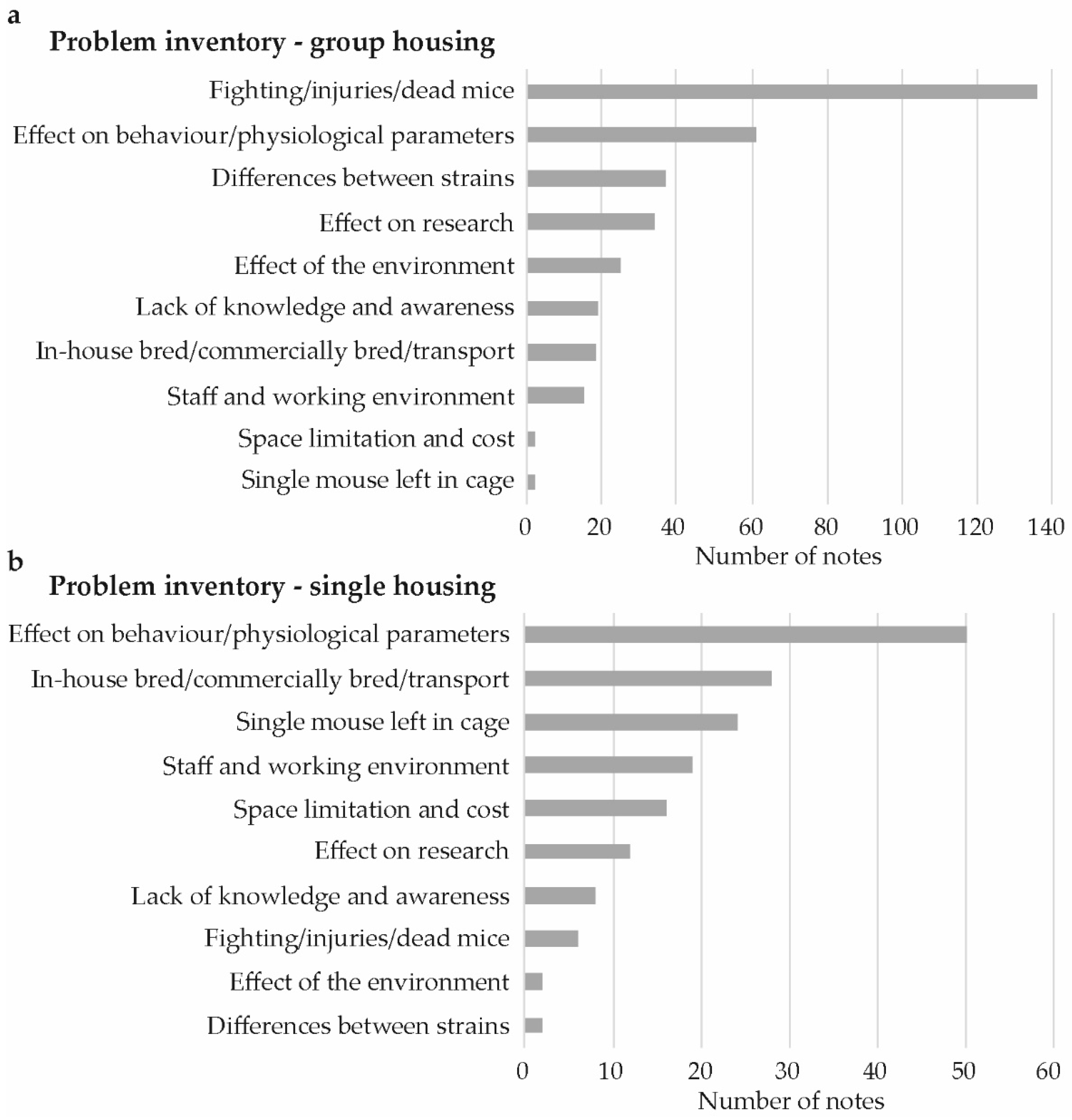
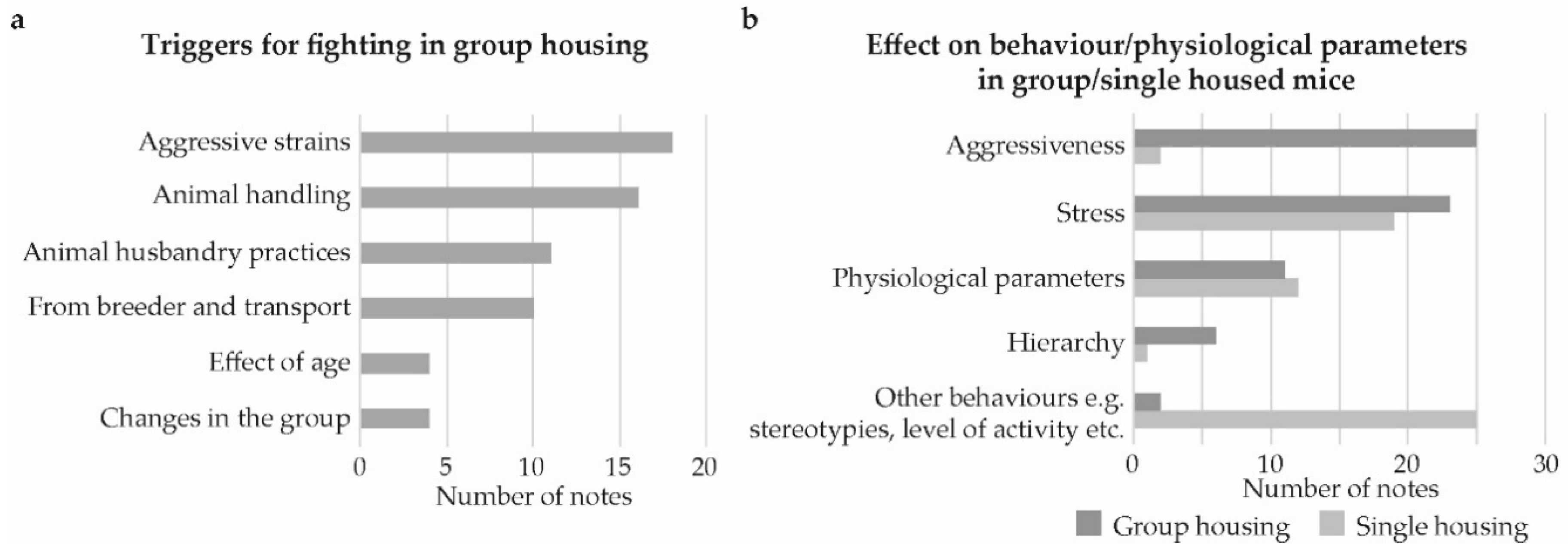

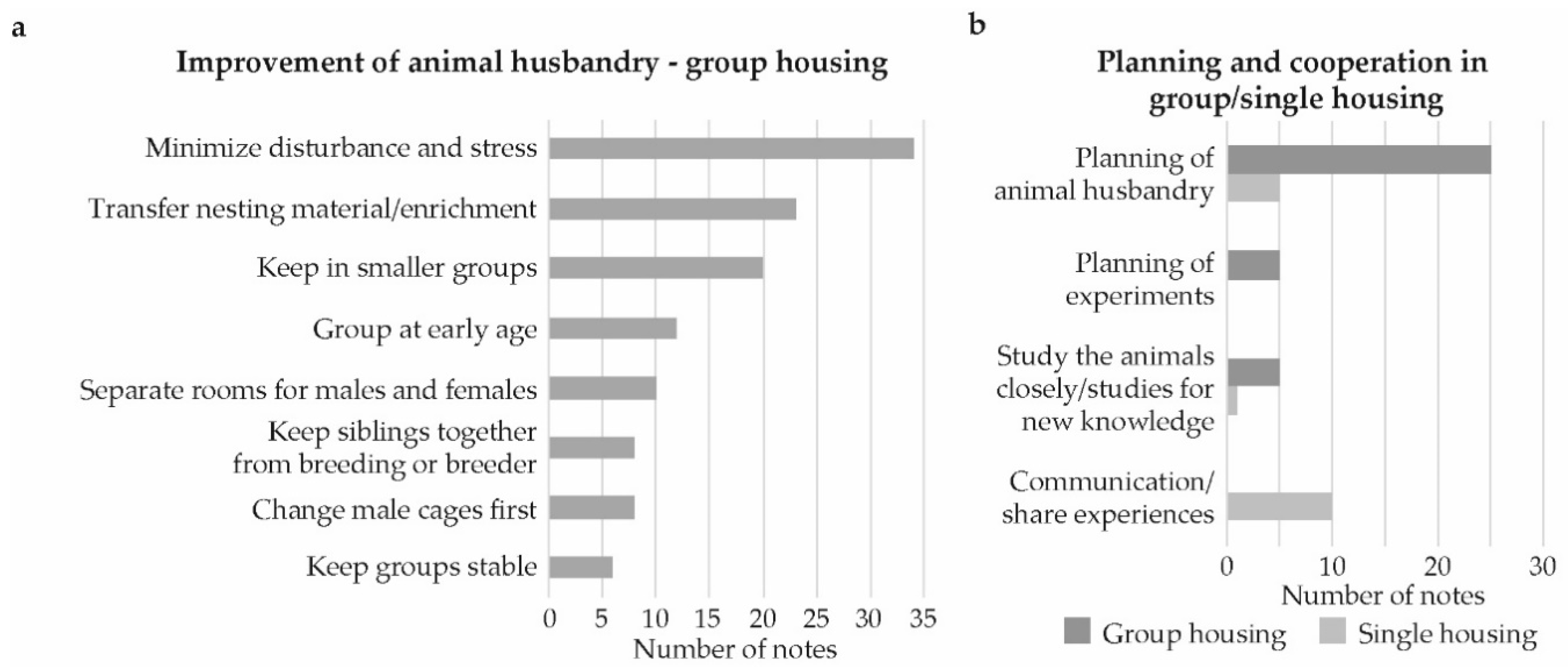
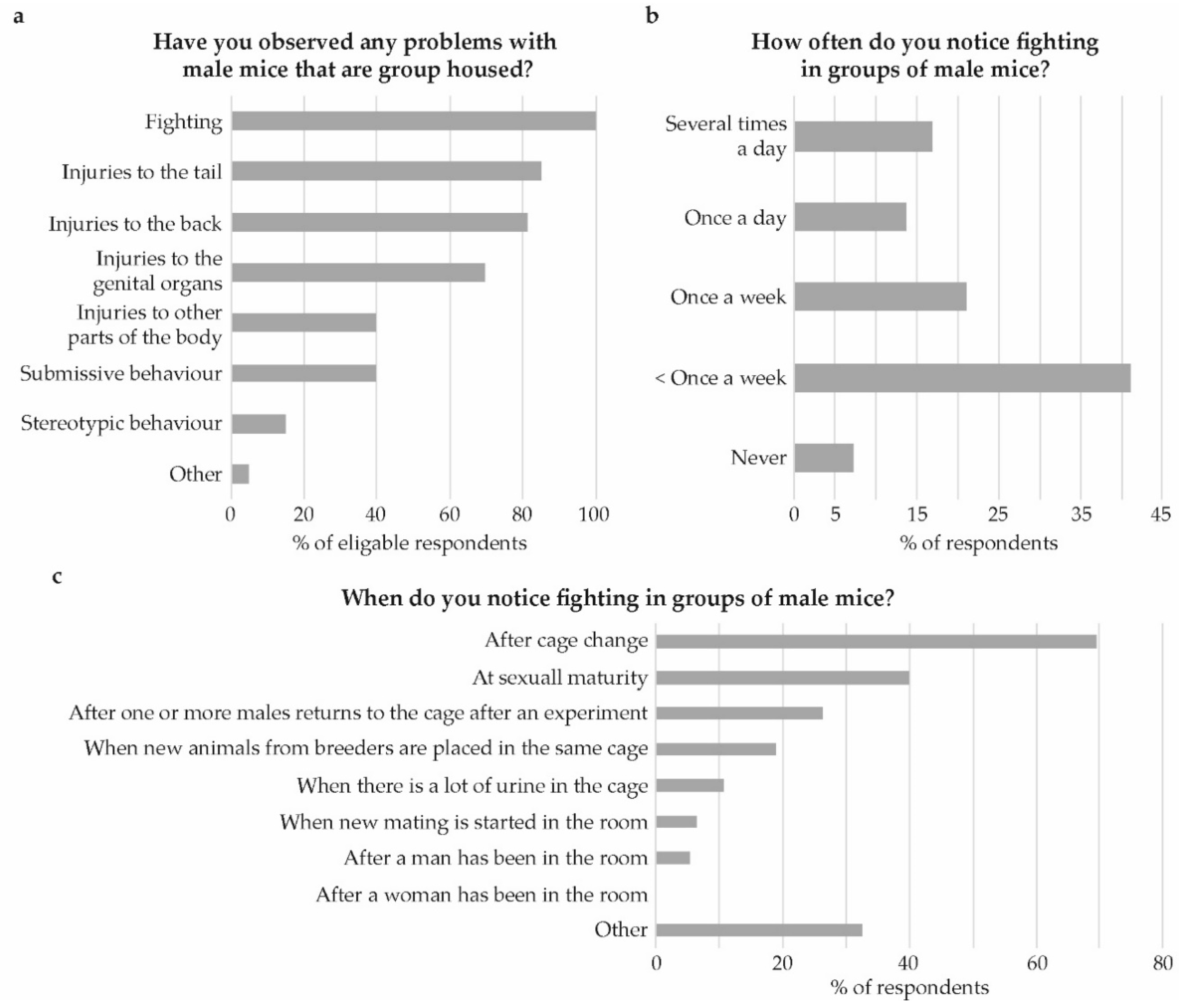
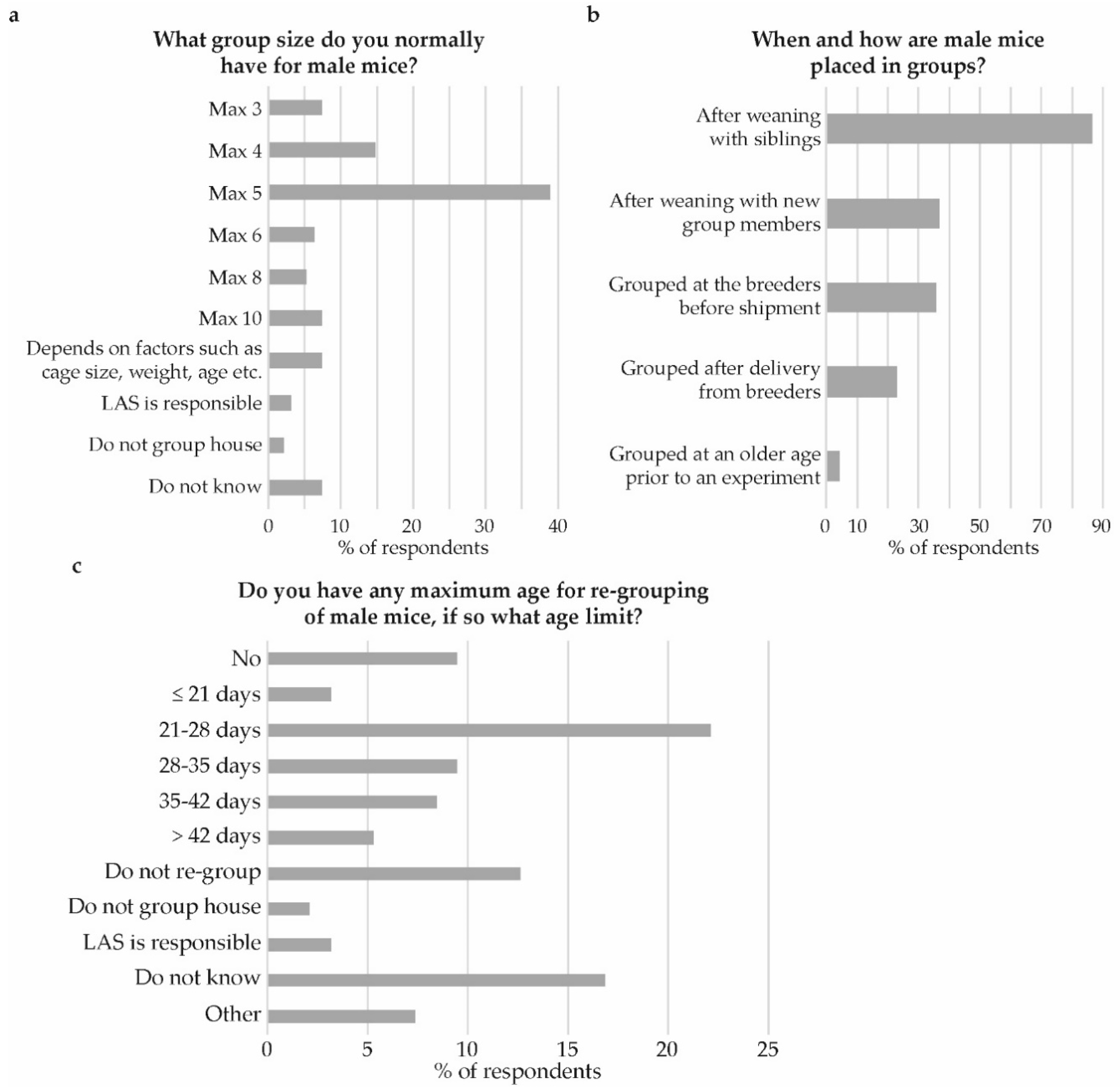
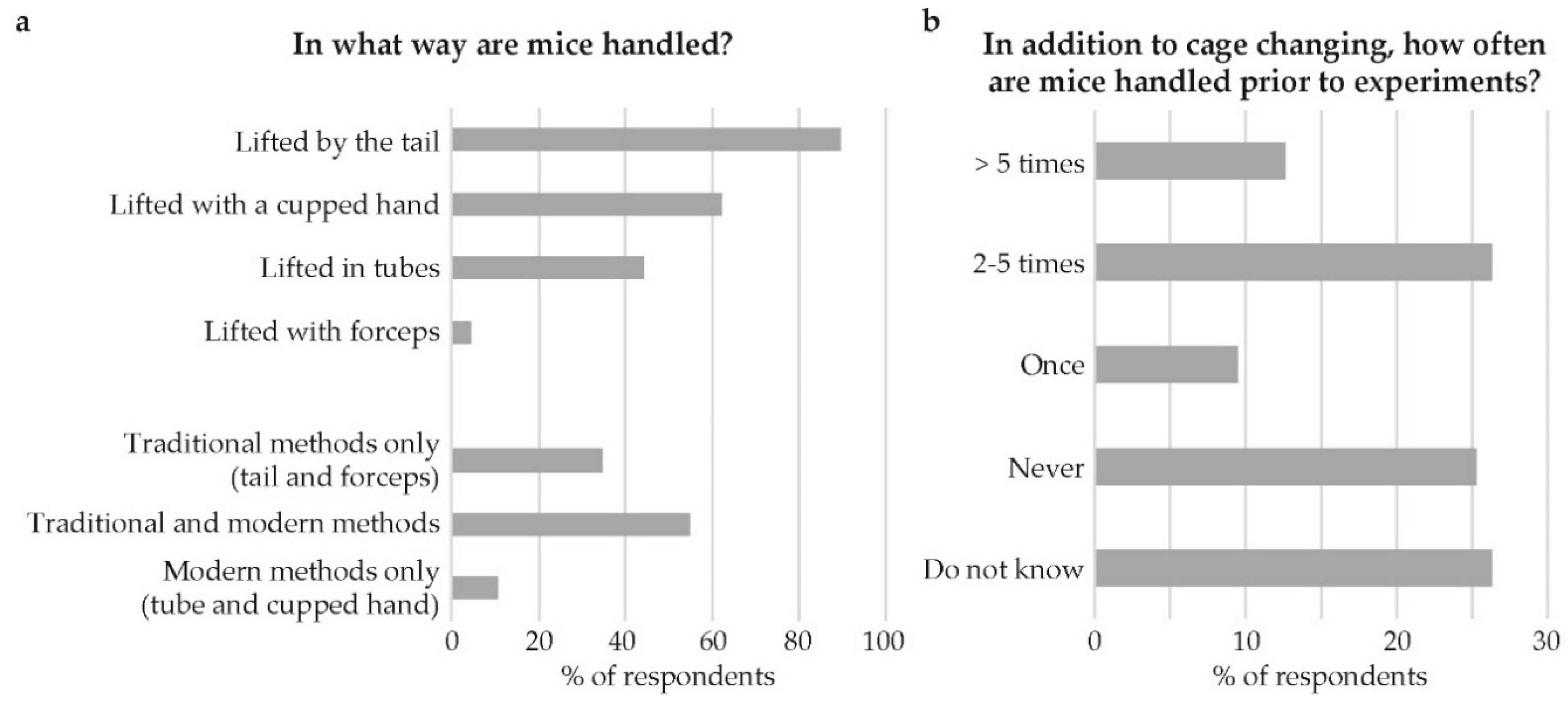
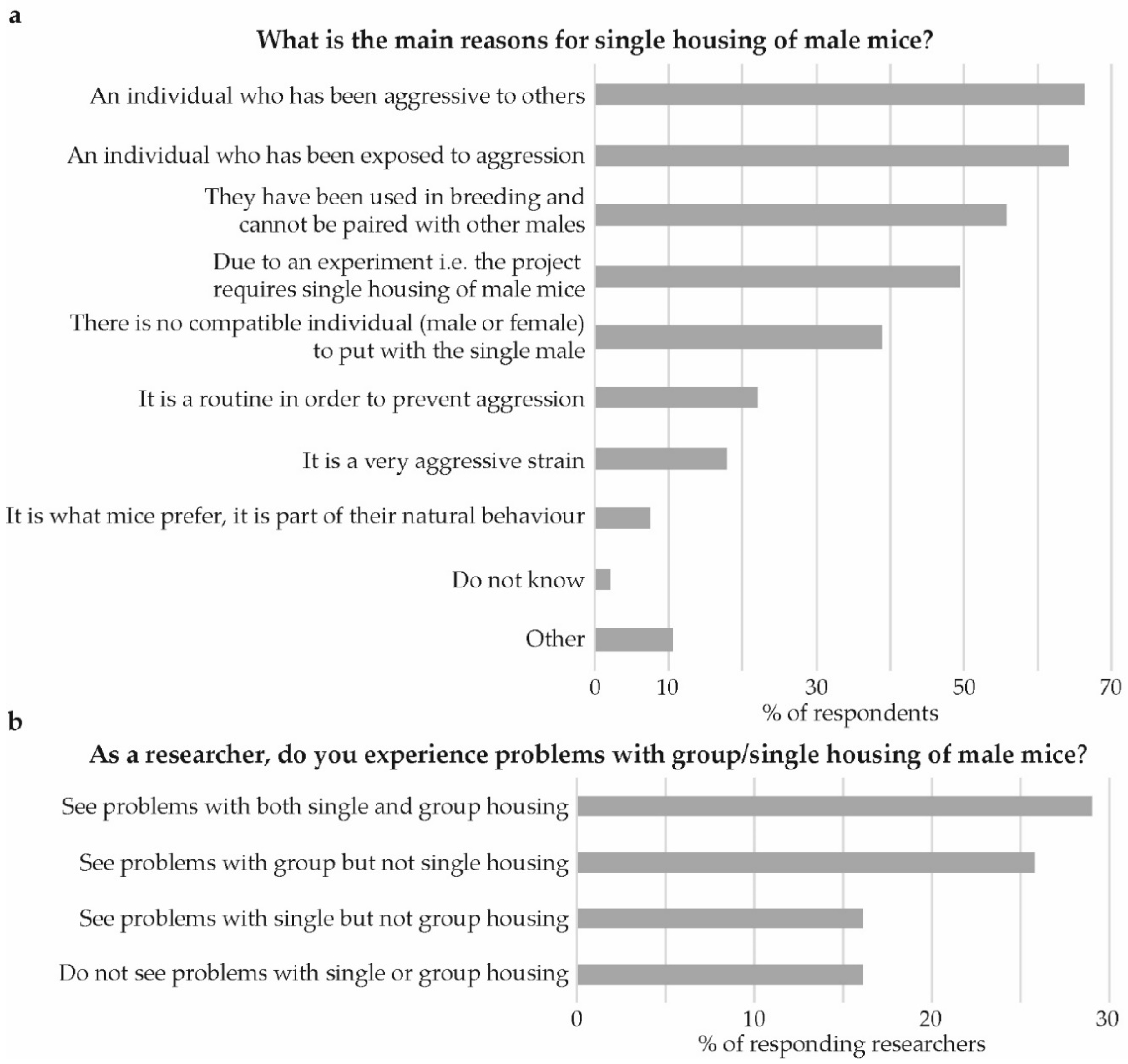
| Effect on Aggression | |||||||
|---|---|---|---|---|---|---|---|
| Attempted Actions | Considerably Reduced | Slightly Reduced | No Effect | Slightly Increased | Considerably Increased | Not Tested | Do Not Know |
| Establish groups before sexual maturity | 35 | 17 | 13 | 0 | 0 | 11 | 19 |
| Transfer old nesting material to new cages | 15 | 31 | 14 | 4 | 0 | 5 | 26 |
| Transfer old enrichment to new cages | 15 | 30 | 17 | 2 | 0 | 6 | 25 |
| Provide extra nesting material | 13 | 28 | 20 | 0 | 0 | 8 | 26 |
| Provide a house/shelter | 9 | 32 | 12 | 4 | 3 | 6 | 29 |
| Provide tunnels | 1 | 24 | 17 | 1 | 3 | 24 | 25 |
| Provide additional environmental enrichment | 3 | 15 | 14 | 0 | 1 | 35 | 27 |
| Handle males and females separately | 8 | 9 | 11 | 0 | 0 | 39 | 28 |
| Avoid enrichment that causes competition | 5 | 12 | 8 | 0 | 0 | 41 | 29 |
| Use special routines during experimental procedures | 9 | 5 | 9 | 0 | 0 | 43 | 29 |
| Transfer old bedding to new cages | 2 | 12 | 15 | 2 | 2 | 38 | 24 |
| Provide chewing sticks | 1 | 11 | 31 | 1 | 1 | 21 | 29 |
| Enable food-seeking behavior to some degree | 0 | 12 | 15 | 1 | 1 | 40 | 26 |
| Provide a shelf/balcony | 2 | 5 | 5 | 0 | 1 | 59 | 23 |
| Provide an exercise wheel | 2 | 3 | 5 | 0 | 3 | 60 | 22 |
| Provide scented enrichment (a scent to prevent fighting) | 2 | 3 | 2 | 0 | 0 | 65 | 23 |
© 2019 by the authors. Licensee MDPI, Basel, Switzerland. This article is an open access article distributed under the terms and conditions of the Creative Commons Attribution (CC BY) license (http://creativecommons.org/licenses/by/4.0/).
Share and Cite
Zidar, J.; Weber, E.M.; Ewaldsson, B.; Tjäder, S.; Lilja, J.; Mount, J.; Svensson, C.I.; Svensk, E.; Udén, E.; Törnqvist, E. Group and Single Housing of Male Mice: Collected Experiences from Research Facilities in Sweden. Animals 2019, 9, 1010. https://doi.org/10.3390/ani9121010
Zidar J, Weber EM, Ewaldsson B, Tjäder S, Lilja J, Mount J, Svensson CI, Svensk E, Udén E, Törnqvist E. Group and Single Housing of Male Mice: Collected Experiences from Research Facilities in Sweden. Animals. 2019; 9(12):1010. https://doi.org/10.3390/ani9121010
Chicago/Turabian StyleZidar, Josefina, Elin M. Weber, Birgit Ewaldsson, Solveig Tjäder, Josefin Lilja, James Mount, Camilla I. Svensson, Emma Svensk, Eva Udén, and Elin Törnqvist. 2019. "Group and Single Housing of Male Mice: Collected Experiences from Research Facilities in Sweden" Animals 9, no. 12: 1010. https://doi.org/10.3390/ani9121010
APA StyleZidar, J., Weber, E. M., Ewaldsson, B., Tjäder, S., Lilja, J., Mount, J., Svensson, C. I., Svensk, E., Udén, E., & Törnqvist, E. (2019). Group and Single Housing of Male Mice: Collected Experiences from Research Facilities in Sweden. Animals, 9(12), 1010. https://doi.org/10.3390/ani9121010





